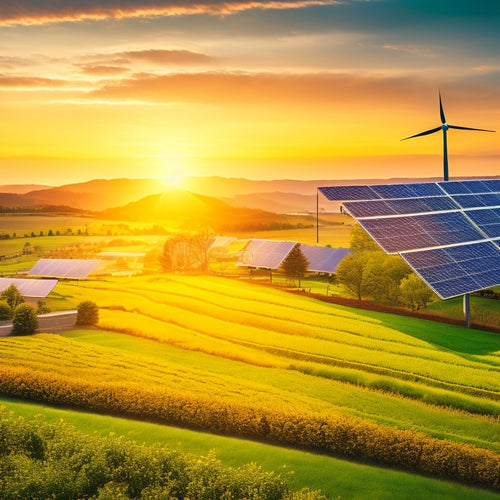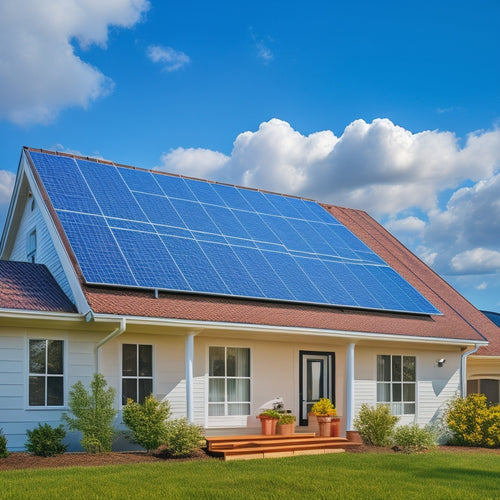
Off Grid Electrical Systems
Share
As you venture into off-grid electrical systems, you're ready to cut ties with utility companies and slash your energy bills. By utilizing renewable energy sources like solar, wind, hydro, geothermal, and biomass, you can achieve energy independence and reap long-term savings. To optimize your system, you'll need to assess your energy demands, select the right power management system, and guarantee inverter synchronization and phase alignment for efficient energy transfer. With higher surge capacity ratings and advanced phase synchronization techniques, you'll protect your system from voltage spikes and electrical storms. Now, get ready to fine-tune your setup for maximum energy independence and cost savings.
The Essentials
- Off-grid electrical systems reduce reliance on utility companies, enabling energy independence and long-term cost savings through renewable energy generation.
- Solar, wind, hydro, geothermal, and biomass energy sources offer varying benefits and drawbacks, such as efficiency, cost, and geographical constraints.
- Proper system design and power management involve assessing energy demands, calculating daily power requirements, and considering surge capacity ratings and load balancing techniques.
- Inverter synchronization and phase alignment are crucial for efficient energy transfer, with advanced techniques minimizing losses and ensuring seamless grid transitions.
- Effective power surge handling techniques, including higher surge capacity ratings and joule-rated surge protection devices, safeguard against equipment damage and fire risks.
Energy Independence Matters Most
You're likely considering an off-grid electrical system because you want to break free from reliance on utility companies and their ever-increasing bills.
By utilizing renewable energy sources, such as solar, wind, or hydro power, you can generate electricity without depleting finite resources or contributing to climate change.
With a well-designed off-grid system, you can enjoy power without the burden of utility bills, giving you true energy independence.
Many homeowners and businesses are turning to off-grid solar power systems to achieve this independence, as it allows them to store excess energy generated during the day for use during periods of low sunlight or at night.
Renewable Energy Sources
One essential aspect of achieving energy independence is identifying reliable renewable energy sources to power off-grid electrical systems. You'll want to take into account the most efficient and cost-effective options for your specific location and energy needs.
| Renewable Energy Source | Advantages | Challenges |
|---|---|---|
| Solar Panels | High solar panel efficiency, low maintenance | Intermittent energy supply, high upfront cost |
| Wind Turbines | Abundant energy source, low operating cost | Noise pollution, visual impact |
| Hydro Power Systems | High energy output, reliable | Limited geographical suitability, high upfront cost |
| Biomass Energy | Renewable, carbon neutral | Fuel quality variability, air pollution |
| Geothermal Heat Pumps | High efficiency, low emissions | High upfront cost, limited geographical suitability |
When selecting a renewable energy source, you should take into account factors such as energy storage solutions, microgrid applications, and off-grid scalability. You'll also want to develop energy transformation strategies that incorporate sustainable energy innovations, ensuring a smooth and efficient shift to off-grid energy independence.
Power Without Utility Bills
Achieving energy independence is the holy grail of off-grid living, and it all boils down to one fundamental benefit: power without utility bills.
You're no longer tied to the grid, and you don't have to worry about monthly electricity costs. With a well-designed off-grid electrical system, you can generate your own power using renewable energy sources like solar or wind.
Renewable Energy Cost Savings
When you opt for an off-grid electrical system, you'll markedly reduce your renewable energy expenses.
By utilizing natural resources like solar, wind, or hydro power, you'll generate clean energy and slash your reliance on traditional utility companies, leading to substantial energy bill reductions.
With efficient and durable residential solar panels, you can maximize your energy output while minimizing your environmental footprint.
As you calculate the costs and benefits of your system, you'll find that the long-term savings will more than justify the initial investment.
Renewable Energy Expenses
Several factors influence the expenses associated with renewable energy systems, and understanding these costs is essential to maximizing your savings. The initial investment in renewable energy systems, such as solar panels or wind turbines, can be substantial. However, this upfront cost is often offset by long-term savings on your energy bills.
Additionally, many governments offer incentives, such as tax credits or rebates, to encourage the adoption of renewable energy systems. By installing solar power systems, individuals can greatly reduce their reliance on the grid and lower their monthly energy expenses Energy Efficiency.
Moreover, solar power is a clean and renewable source of energy, producing no emissions or pollution, which helps mitigate climate change and protects the environment for future generations.
When calculating the expenses associated with renewable energy systems, you should evaluate the cost of the equipment, installation, and maintenance. You should also factor in the cost of energy storage systems, such as batteries, if you plan to store excess energy generated by your system.
Additionally, you may need to assess the cost of upgrading your electrical infrastructure to accommodate the renewable energy system.
Energy Bill Reduction
As you integrate renewable energy systems into your off-grid electrical setup, you'll start to notice a significant reduction in your energy bills. This is because renewable energy sources like solar and wind power are free and abundant, reducing your reliance on traditional energy providers. By utilizing these energy sources, you'll not only reduce your energy bills but also contribute to a more sustainable future.
Here's a breakdown of the energy bill reduction you can expect from different renewable energy systems:
| System | Average Energy Bill Reduction | Payback Period |
|---|---|---|
| Solar PV | 50-75% | 5-7 years |
| Wind Turbine | 30-50% | 7-10 years |
| Hybrid System | 70-90% | 5-10 years |
| Geothermal | 80-90% | 10-15 years |
| Biomass | 60-80% | 7-12 years |
Inverter Synchronizes AC Output
When you're designing an off-grid electrical system, you'll need to guarantee that your inverter synchronizes its AC output with the grid's waveform, especially when relying on renewable energy systems such as off-grid solar systems to power your remote home.
This is vital for a seamless changeover between grid and inverter power. This requires syncing AC waveforms, which involves matching the inverter's output frequency, voltage, and phase angle to the grid's sinusoidal waveform.
Syncing AC Waveforms
Your inverter's ability to synchronize its AC output waveform with the grid's AC waveform is essential for seamless grid-tie operation. This synchronization process involves waveform analysis to guarantee that your inverter's output waveform is identical to the grid's waveform regarding frequency, amplitude, and phase.
To achieve this, your inverter's control system continuously monitors the grid's waveform and adjusts its output waveform accordingly. Frequency stabilization is critical in this process, as any deviation from the grid's frequency can cause the inverter to disconnect from the grid.
You'll need to verify that your inverter's synchronization algorithm is strong and accurate to prevent any disruptions to the grid-tie operation. A good synchronization algorithm will be able to detect any changes in the grid's waveform and adjust the inverter's output waveform in real-time.
This guarantees that your off-grid electrical system operates in harmony with the grid, providing you with reliable and efficient power generation. With proper synchronization, you can enjoy the benefits of grid-tie operation, including increased efficiency and reduced energy costs.
Phase Alignment Control
Phase Alignment Control, a critical component of the synchronization process, guarantees your inverter's AC output waveform is perfectly aligned with the grid's waveform regarding phase. This precise control is essential for efficient and safe energy transfer. When you're off the grid, your inverter's output must match the grid's frequency, amplitude, and phase to confirm seamless integration.
| Phase Alignment Control | Impact on Energy Transfer |
|---|---|
| Perfect phase alignment | Maximum energy transfer, minimal losses |
| 10° phase shift | 15% reduction in energy transfer, increased losses |
| 30° phase shift | 50% reduction in energy transfer, considerable losses |
| 60° phase shift | Minimal energy transfer, high losses |
| 90° phase shift | No energy transfer, maximum losses |
As shown in the table, even a slight phase shift impact can considerably reduce energy transfer and increase losses. That's why your inverter must employ advanced phase synchronization techniques to confirm perfect phase alignment control. By doing so, you can enjoy efficient, reliable, and safe energy transfer, giving you the freedom to live off the grid with confidence.
Assess Your Energy Demands
You'll need to understand your energy usage patterns to determine your daily power requirements accurately.
Start by tracking your energy consumption over a week or a month to identify your peak and off-peak usage periods.
Consider investing in renewable energy sources like solar panels to reduce your reliance on the grid and lower your energy bills.
This data will help you calculate your total daily energy demand in watt-hours (Wh), which is essential for sizing your off-grid electrical system.
Energy Usage Patterns
One essential step in designing an off-grid electrical system is to accurately assess energy demands, as it directly impacts the system's overall performance and reliability.
You'll need to understand your energy consumption patterns to determine the capacity of your off-grid system. This involves conducting a thorough usage analysis to identify your energy-intensive appliances and their corresponding power ratings.
Start by making a list of all your electrical appliances, including lighting, refrigeration, heating, and cooling systems. Then, estimate their daily energy consumption in watt-hours (Wh). Consider your usage habits, such as the number of hours you use each appliance daily. For instance, if you have a 100W refrigerator that runs for 8 hours a day, its daily energy consumption would be 800Wh.
Next, categorize your appliances into essential and non-essential loads. Essential loads include critical systems like lighting, refrigeration, and communication devices. Non-essential loads include appliances like TVs and hair dryers.
Daily Power Requirements
Accurately evaluating daily power requirements is vital to designing an off-grid electrical system that meets your energy demands. To do this, you'll need to calculate your total daily energy usage in watt-hours (Wh).
Start by identifying the off-grid appliances you'll be using, such as refrigerators, lights, and computers, and their respective power ratings. Then, estimate the number of hours each appliance will be used daily.
Consider factors like solar panel efficiency, which affects the amount of energy your system can generate. You'll also need to think about energy storage solutions, such as batteries, and how they'll be managed through battery management systems.
Load balancing techniques can help guarantee that your system can handle peak energy demands. If you're considering a grid-tied system, you'll need to factor in backup power options for when the grid is down.
Use energy monitoring tools to track your energy usage and adjust your system accordingly. Weather impact analysis is also significant, as it affects the amount of energy your solar panels can generate.
Higher Surge Capacity Ratings
When selecting an off-grid electrical system, you'll need to take into account its power surge handling capabilities.
This is critical because your system will be exposed to voltage spikes and electrical storms that can damage your equipment.
A higher surge capacity rating guarantees your system can absorb and dissipate these power surges, protecting your investment and maintaining system reliability.
Power Surge Handling
Most off-grid electrical systems are designed to handle typical power surges, but higher surge capacity ratings are vital for systems that require extra protection. You can't afford to compromise on electrical safety when you're relying on your off-grid system for power. A power surge can be devastating, causing damage to your equipment, and even starting a fire.
When selecting a surge protection device, you need to evaluate the level of protection you require. Look for devices with higher surge capacity ratings, typically measured in joules. A higher rating indicates the device can absorb more energy from a power surge, providing better protection for your system.
You should also assess the response time of the device, as a faster response time guarantees that your system is protected quickly. Additionally, confirm that the device is specifically designed for off-grid systems, as they often have unique requirements.
Frequently Asked Questions
Can I Use Off-Grid Electrical Systems in Urban Areas?
You can achieve energy independence in urban areas by utilizing urban solar power, installing rooftop panels, and utilizing energy storage systems, allowing you to disconnect from the grid and enjoy autonomy, freedom from utility bills, and a reduced carbon footprint.
Are Off-Grid Systems Compatible With Existing Electrical Infrastructure?
When integrating alternative energy sources with existing infrastructure, you'll find that system integration is key to achieving energy independence, allowing you to seamlessly switch between grid power and your off-grid system, ensuring a reliable and self-sufficient energy supply.
How Often Do I Need to Replace Batteries in Off-Grid Systems?
You'll need to replace your batteries every 5-15 years, depending on the type and quality, as well as factors like depth of discharge and charging cycles, watching for replacement indicators like capacity loss, swelling, or corrosion to guarantee peak performance.
Can I Add More Solar Panels to My Off-Grid System Later?
You can always scale up your energy harvesting capacity by adding more solar panels, ensuring seamless solar panel integration and enhancing energy efficiency, giving you the freedom to expand your off-grid system as your power needs evolve.
Do Off-Grid Systems Require Regular Maintenance and Inspections?
Coincidentally, your newfound freedom from the grid relies on regular tune-ups; you'll want to inspect and maintain your system regularly to guarantee system longevity, so make certain to follow essential maintenance tips to keep your independence shining bright.
Final Thoughts
As you break free from the grid's shackles, your off-grid electrical system becomes a guiding light of self-sufficiency, illuminating your path to energy independence. With every kilowatt-hour harvested from the sun or wind, you're weaving a fabric of cost savings and sustainability. Your inverter's synchronized hum harmonizes with nature's rhythms, while your carefully calibrated system hums along, surge capacity at the ready to shield you from life's unexpected storms.
Related Posts
-

Net Metering in Renewable Energy's Future
Net metering's future is vital for driving renewable energy growth and financial savings. You can reduce your electri...
-

Cost of Solar Panel Installation
You can expect to pay between $15,000 and $30,000 or more for a typical solar panel installation, depending on the sy...
-

Top Camping Water Bottles for Adventure
When you're out adventuring, picking the right camping water bottle is essential for staying hydrated. Look for durab...


